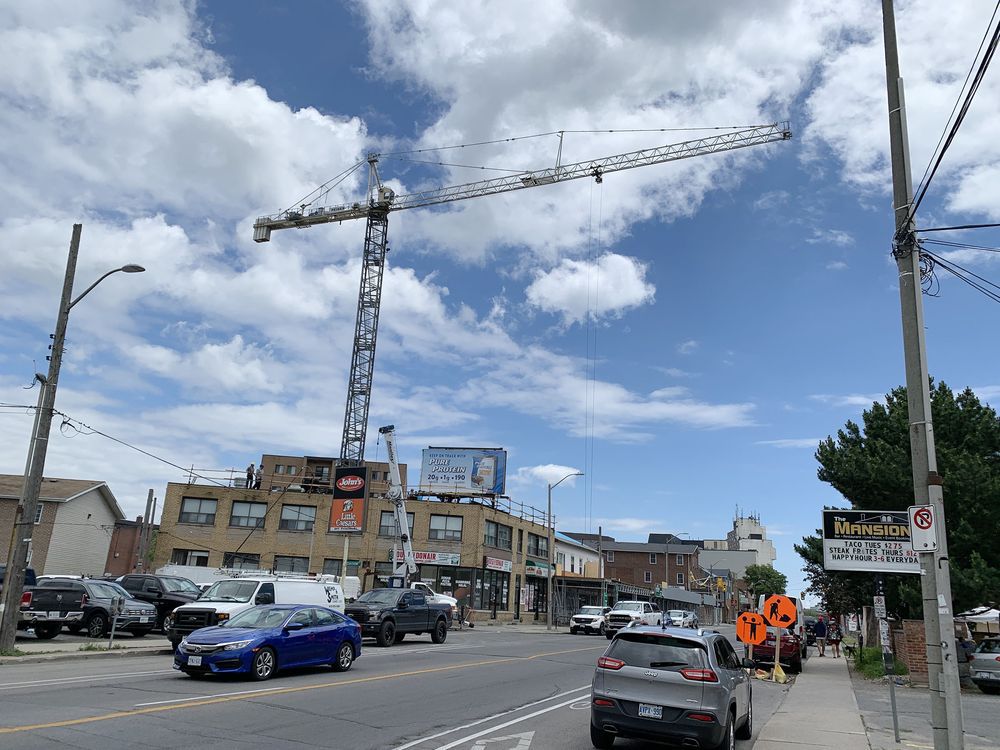A construction crane looms over a building site on Princess Street in Kingston on June 24, 2020. (Elliot Ferguson/The Whig-Standard)
KINGSTON — Known for a stable market largely immune to the wild price and availability swings in other areas, even Kingston’s real estate sector suffered the ill effects of the COVID-19 pandemic.
While that stability will help with the sector’s recovery in the coming months, the ability of local real estate to bounce back will depend very much on how other areas of the economy recover.
“The pandemic is proving to have very significant impacts on the real estate industry — both residential and commercial. Some short-term and others long-term,” said John Andrew, a real estate professor at Queen’s University’s schools of urban and regional planning and business and environmental studies.
“On the residential side, the obvious short-term impact was real estate agents’ inability to show homes. While sales volumes fell dramatically, they are now recovering nicely, and prices have for the most part held firm,” said Andrew, director of the Queen’s Real Estate Roundtable.
“On the commercial side, the hardest hit type of property is obviously retail. In Kingston we have seen many stores unable or unwilling to pay rent to their landlords and some stores have closed and vacated their space.”
Since the pandemic began, real estate sales in the Kingston area dropped more than 25 per cent — worth more than $500 million — from the same time period last year.
Active listings are down by more than 17 per cent.
The drop in the number of sales was partially offset by higher average prices for the properties that did sell.
The average price of a home is up 8.8 per cent from 2019, to just more than $432,000.

A residential construction site in the west end of Kingston on June 24, 2020. (Elliot Ferguson/The Whig-Standard)
Elliot Ferguson /
Elliot Ferguson/Whig-Standard
“You are correct by saying that Kingston’s real estate market is different from many other markets across the country, however, when it comes to this pandemic, we are seeing similar results,” said realtor Dave Pinnell Jr., president of Kingston and Area Real Estate Association.
At the outset of the pandemic only “essential transactions” that were finalized or close to firmed up were allowed to go through.
“In the early days of the pandemic, realtors were informed by the provincial government that ‘business would not be as usual,’ ” Pinnell said. “Although the term ‘essential’ was a bit vague to the industry, it did not take long for the sellers to suspend or cancel their listings until further information about the pandemic was known.”
The chill that went through the sector affected not only real estate agents but also mortgage companies, lawyers, movers, cleaners, home stagers, home inspectors and photographers.
As the restrictions around real estate were eased, realtors did what they could to adapt to the new environment, Pinnell said.
Open houses are now offered virtually, limiting access to houses for sale to only the selling agent – wearing a mask and gloves. The homeowners were encouraged to turn on all the lights and open all the doors in the house to reduce the need for the sell agent to touch any surfaces.
Pinnell said he expects technology to continue to play a bigger role in the industry.
“There will be a ‘new normal.’ The real estate industry has already seen dramatic changes in the way that our day day business is conducted and in some ways, for the best,” he said.
“Meetings are being conducted virtually and more frequently, more technology is, and will, continue to be used to market properties. We will see the use of more videos and virtual open houses are here to stay.”
In April, the Conference Board of Canada ranked Kingston as the fourth most vulnerable city in the country to the economic effects of the pandemic, and the Kingston Economic Development Corporation estimated almost a quarter of the city’s workforce is in sectors considered highly vulnerable, including the tourism, restaurant and accommodation sectors.
For those workers, the success of local tourism strategies will determine how quickly the city’s hotels, retail stores and restaurants recover and people get back to work, Andrew said.
With the international border closed, the local tourism sector – which in 2019 attracted 4.5 million visitors to the city and generated an economic impact of $533 million – will need to appeal to domestic visitors and even if visitors return, physical distancing rules could make business difficult, he said.

A construction site on Princess Street in Kingston on June 24, 2020. (Elliot Ferguson/The Whig-Standard)
Elliot Ferguson /
Elliot Ferguson/Whig-Standard
“How does a restaurant make money if it can only operate a patio (weather-dependent) and/or only operate 30-50 per cent of its tables? Many won’t survive,” Andrew said.
Physical distancing measures may change other workplaces, too.
“Office space is the big unknown. If you need to have social distancing, most companies can’t afford to double or triple their office space,” he said.
Rental property owners, particularly those renting at the lower end of the price market, face challenges on both the supply and demand sides, Andrew said.
More student housing units are expected to become available in the coming months.
But with post-secondary classes to be delivered online in the fall semester, many students may not return to the city until January if classes in the winter semester return to an in-person format.
“Residential landlords are aware that the next six to 12 months will be very challenging,” Andrew said.
The pandemic has also forced some short-term rental owners to rethink their business plans.
“It has been pretty bad for most home-share hosts, albeit not nearly as devastating as it could have been absent federal support from the CERB program and the incredible speed at which it was rolled out,” said Airbnb host Ron Hartling.
“Some hosts have essentially abandoned the sector, including one couple who sold their principal residence and made their rental unit into their new home.”
At the height of the first wave of the pandemic, some home-share hosts with empty rooms to fill offered them to essential workers looking to limit potential exposure to their families.

A residential construction site in the west end of Kingston on June 24, 2020. (Elliot Ferguson/The Whig-Standard)
Elliot Ferguson /
Elliot Ferguson/Whig-Standard
As restrictions are lifted, Hartling said new requirements about intense cleaning and sanitizing rooms will make short stays of a less than three nights uneconomical to provide. Instead, hosts are likely to offer stays of about a week at least.
And with the border closed, visitors from the region will be the market for many hosts for the foreseeable future.
“Visitors from still-infected areas are the most likely vectors for such outbreaks in our area,” Hartling said. “That leaves me torn between welcoming a tourism re-start, which could provide relief hosts who are hurting from their loss of income, and jumping in too soon before we can reliably gauge the likelihood and severity of new outbreaks.”
COVID-related restrictions hit this area just as progress was being made to address the ongoing housing shortage that has strained the affordability and availability of rental housing.
In January, the Canada Mortgage and Housing Corporation put the rental vacancy rate in the Kingston Census Metropolitan Area — which includes Frontenac Islands, Loyalist and South Frontenac townships — at 1.9 per cent in 2019, the first increase in five years and a more than threefold increase from 2018’s record low rate of 0.6 per cent.
The increase put Kingston close to Ontario’s average rental vacancy rate of two per cent.
Housing construction was permitted during all phases of the pandemic and to keep new supply coming, the city supported those projects as best it could.
“Some projects have experienced minor delays due to provincial pandemic restrictions, so the city is expecting new rental units to be coming online more gradually than originally expected. But a number of already permitted projects have seen continuous building activity,” said Andrea Gummo, the city’s manager of policy planning, planning services.
By the end of May, the city had issued permits for 406 residential units, including 239 multi-unit residential units and 45 secondary suite units.
During the same period last year, 516 permits had been issued, although 2019 saw an unusually high number of building permits issued.
Efforts to ease the housing crunch had already started to show results and Andrew said until the Queen’s University and St. Lawrence College students return to the city en masse, and until the borders reopen allowing international students to come back, there may be too much supply in the housing market.
It could be a year before a true picture of the city’s housing market can be seen again.
“I believe the housing shortage was gradually coming to an end anyway, especially in student housing due quite a few new, large apartment projects now underway, especially in the Williamsville District,” Andrew said. “We will soon have a surplus of space , again at the low, student-end of the spectrum because some students won’t be renting places and some of those that have won’t be paying rent for a place they aren’t occupying.”

A construction crane looms over a building site on Princess Street in Kingston on June 24, 2020. (Elliot Ferguson/The Whig-Standard)
Elliot Ferguson /
Elliot Ferguson/Whig-Standard
























